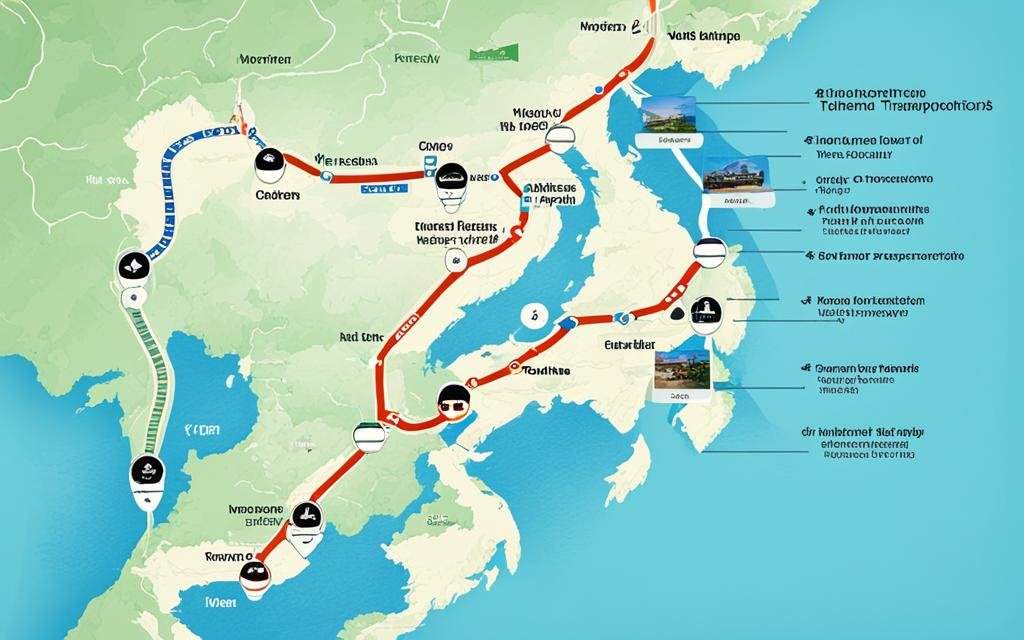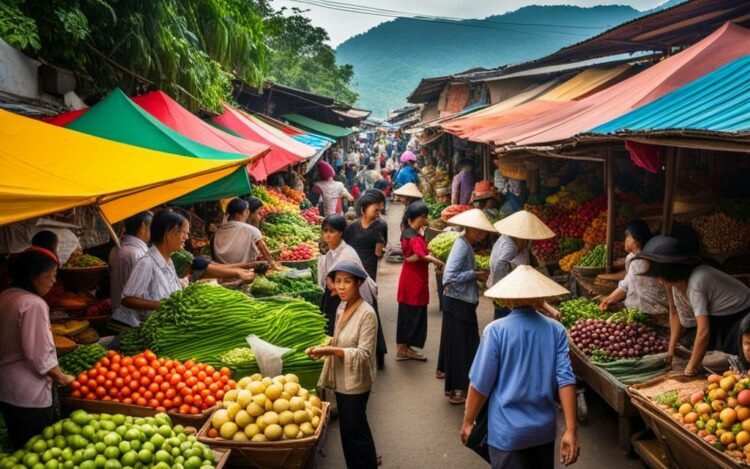Vietnam is a captivating destination that offers a remarkable blend of natural beauty, rich history, and vibrant culture. If you’re considering a 10-day trip to Vietnam, it’s essential to plan your budget effectively to make the most of this remarkable country. In this article, we will delve into the cost of a 10-day trip to Vietnam, covering travel expenses, accommodation, transportation, food, and must-visit tourist attractions. By understanding the costs involved, you can create a well-planned budget that ensures an unforgettable experience in Vietnam.
Key Takeaways:
- Plan your budget effectively to make the most of your 10-day trip to Vietnam.
- Explore a range of accommodation options, from budget-friendly hostels to luxurious hotels.
- Consider affordable transportation options, including flights, buses, and local transport.
- Experience the diverse and delicious Vietnamese cuisine from street food to local restaurants.
- Discover the wealth of tourist attractions in Vietnam, ensuring you budget for entrance fees and activities.
Accommodation Costs in Vietnam
Accommodation in Vietnam offers a range of options to suit different budgets. Whether you’re a budget traveler looking for affordable stays or seeking a touch of luxury, Vietnam has something for everyone.
For budget-conscious travelers, hostels are a popular choice. You can find dorm beds starting from $5 to $15 per night. If you prefer the privacy of a private room, prices range from $20 to $40 per night in hostels.
Hotels in Vietnam are reasonably priced, making them an attractive option for mid-range travelers. You can expect to spend around $20 to $60 per night for comfortable accommodation.
For those seeking a touch of luxury, Vietnam boasts a selection of high-end hotels. Luxury hotels with premium amenities and services are available for $100 or more per night.
In addition to the traditional options, you may also come across guesthouses offering affordable stays, especially in rural areas or off-the-beaten-path destinations.
If you’re looking to eliminate accommodation costs entirely, consider alternative options like housesitting or volunteering opportunities, which may provide free accommodation in exchange for services.
Summary:
- Hostels: $5 to $15 per night for dorm beds
- Hostels: $20 to $40 per night for private rooms
- Hotels: $20 to $60 per night for mid-range options
- Luxury hotels: $100 or more per night for a premium experience
- Consider guesthouses and alternative options like housesitting or volunteering for budget-friendly or free stays
Transportation Costs in Vietnam
When planning your trip to Vietnam, it’s important to consider the transportation costs. Fortunately, transportation in Vietnam is known to be affordable and convenient, offering various options to suit your budget and travel preferences.
Flights
If you’re traveling between different cities in Vietnam, taking a flight can be a time-saving option. Prices for domestic flights can vary depending on the season and availability. To find the best deals, consider using comparison sites like Skyscanner. They allow you to compare prices from multiple airlines and choose the most cost-effective option for your journey.
Buses
Another common mode of transportation within Vietnam is buses. They offer a reliable and budget-friendly way to get around the country. Prices for local bus journeys typically range around $12, making it an affordable option for traveling between cities or exploring nearby areas. Additionally, buses provide an opportunity to experience the local culture and interact with fellow travelers.
Local Transport
For shorter distances within cities or towns, local transportation options like taxis or motorbike rentals can be budget-friendly alternatives. Taxis are widely available and offer convenience, especially when traveling with heavy luggage or in a group. Motorbike rentals allow you to explore at your own pace and immerse yourself in the local surroundings. Both options offer flexibility and ease of transportation, allowing you to navigate through Vietnam’s vibrant streets.
To make the most of your transportation budget, consider a combination of these options depending on your itinerary. Flights can save you time when traveling long distances, while buses and local transport provide cost-effective solutions for shorter journeys and exploring specific areas.
Remember to research prices, plan your routes in advance, and keep transportation costs in mind when budgeting for your 10-day trip in Vietnam.

Food Costs in Vietnam
Vietnam is renowned for its mouthwatering street food and the affordability it offers. When exploring the vibrant streets and markets, you’ll find a wide array of delectable meals at incredibly low prices. Street stalls or local markets are prime spots to indulge in Vietnamese street food, with meals available for as little as $1 to $2.
For those seeking a more diverse dining experience, restaurants in Vietnam offer an extensive selection of dishes. Whether you’re craving a steaming bowl of pho or a flavorful banh mi sandwich, restaurants have got you covered. Prices for a basic meal at these establishments typically range from $5 to $10, making it a budget-friendly option for those looking to sample a variety of local cuisine.
It’s impossible to overlook the importance of trying the local cuisine when in Vietnam. The country’s rich culinary heritage is a testament to the flavors and aromas that grace the streets and restaurants. Exploring the vibrant street food scene and indulging in local delicacies is an essential part of any trip to Vietnam, allowing you to immerse yourself in the culture and local flavors.
To get a glimpse of the vibrant street food culture in Vietnam, here’s an enticing image featuring a bowl of mouthwatering pho:
Top Vietnamese Street Foods
- Pho – A delicious noodle soup with savory broth, tender meat, and fragrant herbs.
- Banh Mi – A French-inspired baguette sandwich filled with a variety of meats, pate, pickled vegetables, and herbs.
- Goi Cuon – Fresh spring rolls packed with herbs, vegetables, rice noodles, and shrimp or pork.
- Banh Xeo – Savory pancake made with rice flour and filled with bean sprouts, shrimps, and pork.
- Com Tam – Broken rice served with grilled pork, a fried egg, and pickled vegetables.
From street food stalls to restaurants, Vietnam offers a culinary adventure that won’t break the bank. So, prepare your taste buds and embark on a gastronomic journey through the flavorsome streets of Vietnam. Be sure to savor the local cuisine while keeping your food costs in check.
Cost of Tourist Attractions in Vietnam
Vietnam offers a plethora of tourist attractions that cater to various interests. From natural wonders to cultural landmarks, there is something for everyone to enjoy. While entrance fees for popular attractions like Halong Bay or the Mekong Delta can vary, budgeting around $20 per activity is a good estimate to ensure you can make the most of your sightseeing experiences.
Visiting Halong Bay, a UNESCO World Heritage Site known for its breathtaking limestone karsts and emerald waters, often requires a fee to access the bay itself. The average entrance fee for a Halong Bay cruise ranges from $15 to $30, depending on the duration and type of excursion.
The Mekong Delta, another iconic destination, offers an array of experiences, including boat tours, floating markets, and cycling adventures. Entrance fees for these activities usually range from $5 to $20, depending on the duration and specific itinerary.
Did you know? Some attractions in Vietnam offer discounted entrance fees for students or senior citizens, so be sure to bring appropriate identification.
Aside from these popular attractions, Vietnam also boasts numerous free or low-cost activities that provide an authentic experience without straining your budget. Exploring local markets, where you can immerse yourself in the vibrant atmosphere and try delicious street food, is a wonderful way to experience the local culture without spending a fortune.
Additionally, visiting temples can be a spiritually enriching experience, and most temples in Vietnam do not charge an entrance fee. They offer a glimpse into the country’s rich history and traditions, allowing you to admire intricate architecture and pay your respects.
Summary:
- Entrance fees for popular attractions in Vietnam, such as Halong Bay and the Mekong Delta, can vary.
- A budget of around $20 per activity is a good estimate for entrance fees.
- Discounted fees may be available for students or senior citizens.
- There are many free or low-cost activities, such as exploring local markets and visiting temples, that provide an authentic experience.
With careful planning and consideration, you can enjoy the diverse tourist attractions and explore the wonders of Vietnam without breaking the bank.

Miscellaneous Costs in Vietnam
When planning your trip to Vietnam, it’s essential to consider the miscellaneous costs that may arise during your travels. These expenses, although smaller in comparison to accommodation and transportation, can add up and impact your overall budget. By accounting for miscellaneous costs such as souvenirs, tipping, alcohol, and additional expenses, you can ensure a more accurate estimation of your total expenditure.
Souvenirs: Vietnam is known for its vibrant markets and unique handicrafts. Whether it’s a traditional ao dai dress or a handcrafted piece of pottery, you may want to bring back souvenirs to commemorate your trip. While prices can vary, setting aside a portion of your budget for souvenirs is recommended.
Tipping: Tipping culture in Vietnam is not as prevalent as in some Western countries, but leaving a gratuity for exceptional service is appreciated. In restaurants, a tip of around 5-10% is customary if a service charge is not already included. It’s also a nice gesture to tip your tour guides or drivers, usually with a small amount.
Alcohol: If you enjoy a drink or two while on vacation, it’s important to factor in the cost of alcohol. Be aware that alcohol prices can vary depending on the establishment and its location. Local beers and spirits tend to be more affordable, while imported beverages can be pricier. Enjoying a cocktail by the beach or a night out in the city can be a delightful experience, but remember to budget accordingly.
Additional Expenses: Miscellaneous expenses can also include unexpected costs, such as laundry services, medication, or unplanned activities that capture your interest along the way. While it’s challenging to predict every possible expense, setting aside an emergency fund or allocating a portion of your budget for unforeseen extras is a wise choice.
By allocating around $10 to $20 per day for miscellaneous expenses, you can ensure that you have enough flexibility in your budget to cover souvenirs, tipping, alcohol, and any additional unforeseen costs that may arise during your trip to Vietnam. Planning ahead and accounting for miscellaneous expenses will help you enjoy a stress-free and memorable experience in this captivating country.
Budgeting Tips for Traveling in Vietnam
When traveling in Vietnam, it’s important to make the most of your budget. By planning ahead and utilizing these budgeting tips, you can save money and still have a fantastic trip. Here are some money-saving strategies and travel hacks to consider:
- Plan and book in advance: By booking your accommodations, transportation, and activities ahead of time, you can secure the best deals and avoid last-minute price hikes.
- Travel during the shoulder season: Visiting Vietnam during the off-peak seasons can help you avoid crowds and high prices. Consider traveling in spring (April-May) or autumn (September-October) for a more budget-friendly experience.
- Eat at local street stalls: Vietnam is famous for its delicious street food. By dining at local street stalls and markets, you can enjoy authentic meals at affordable prices. Don’t miss out on trying pho, banh mi, and other local specialties.
- Use local transportation options: Opt for local transportation such as buses or motorbike rentals to save money on getting around. Public transport is often cheaper than private taxis, and it also gives you a chance to experience the local way of life.
- Haggle for better prices: Bargaining is a common practice in Vietnam, especially in markets and with street vendors. Don’t be afraid to negotiate and haggle for better prices. With a little friendly negotiation, you can score great deals on souvenirs and other items.
By following these budgeting tips, you can make your money go further and have an incredible experience exploring Vietnam without breaking the bank. So start planning your trip, and get ready for an unforgettable adventure!
Conclusion
In summary, Vietnam offers a wealth of experiences at an affordable cost, making it an ideal destination for your 10-day trip. By considering various aspects such as accommodation, transportation, food, tourist attractions, and miscellaneous costs, you can effectively plan your budget and make the most of your time in Vietnam.
When it comes to accommodation, options range from budget-friendly hostels to mid-range hotels and even luxury resorts. Transportation is convenient, with flight comparison sites helping you find the best deals and buses offering affordable local travel. Don’t miss out on the delicious and cheap street food that Vietnam is known for.
When budgeting for tourist attractions, keep in mind that entrance fees can vary but budgeting around $20 per activity is a good estimate. It’s also essential to set aside funds for miscellaneous expenses like souvenirs, tipping, and additional activities. To maximize your budget, consider planning and booking in advance, traveling during the shoulder season, and using local transportation options.
Vietnam is a country that combines affordability with a rich cultural experience. With careful planning and budgeting, you can explore this beautiful country without breaking the bank. So start researching, compare prices, and make informed choices to ensure that your 10-day trip to Vietnam is a memorable and cost-effective adventure.
FAQ
What are the accommodation costs in Vietnam?
Accommodation in Vietnam offers a range of options to suit different budgets. Hostels range from $5 to $15 per night for dorm beds, while private rooms in hostels can range from $20 to $40 per night. Mid-range hotels cost around $20 to $60 per night, and luxury hotels can be found for $100 or more per night.
How much does transportation cost in Vietnam?
Flights within Vietnam vary in price, but using comparison sites like Skyscanner can help you find the best deals. Buses are a common mode of transportation with prices around $12 for local journeys. Local transportation such as taxis or motorbike rentals can also be budget-friendly options for short distances.
What are the food costs in Vietnam?
Vietnam is known for its delicious and affordable street food. Meals can be found for as little as $1 to $2 at street stalls or local markets. Restaurants offer a wider variety of dishes, with prices ranging from $5 to $10 for a basic meal.
How much do tourist attractions cost in Vietnam?
Entrance fees for popular attractions like Halong Bay or the Mekong Delta can vary, but budgeting around $20 per activity is a good estimate. There are also many free or low-cost activities, such as exploring local markets or visiting temples, that provide an authentic experience without breaking the bank.
What are the miscellaneous costs in Vietnam?
Miscellaneous costs when traveling in Vietnam can include souvenirs, tips for service staff, and expenses for alcohol or additional activities not included in your initial budget. Setting aside around $10 to $20 per day should cover these miscellaneous expenses.
What are some budgeting tips for traveling in Vietnam?
To make the most of your budget in Vietnam, consider planning and booking in advance to secure the best deals, traveling during the shoulder season to avoid peak prices, eating at local street stalls for affordable meals, using local transportation options, and haggling for better prices when shopping.

